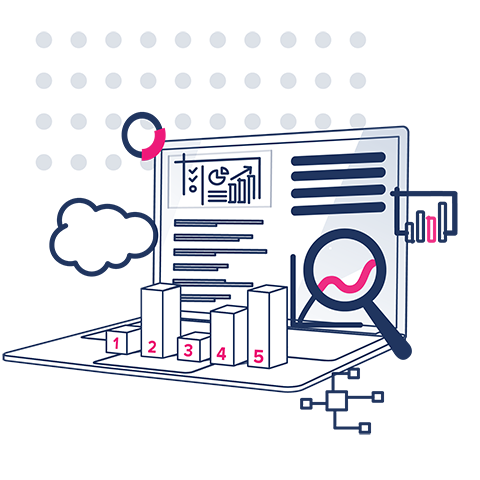
5 financial planning software capabilities that drive business value
Why is it so difficult to build an operational plan that not only keeps pace with changing priorities but also adds meaningful business value? The answer is simple: most organizations use financial planning solutions that lack the adaptability, integration, and simplicity that high-performing teams need to collaborate effectively.
Now finance teams are looking for more efficient and flexible planning that encourages a “total company mindset,” according to the Gartner 2022 Critical Capabilities for Financial Planning Software report.1 As planning solutions evolve to meet this demand, finance leaders must consider which capabilities best fit their organization’s needs.
Finance leaders should look for these five capabilities when selecting financial planning software that will drive business value for their enterprise.
1. Configurable models
Increasing efficiency in an organization’s planning, budgeting, and forecasting processes is a key component of financial planning software, according to Gartner. Solutions that provide “out-of-the-box templates to ease implementation” and “workflow automation to increase efficiency and streamline processes” are especially beneficial in this regard.1
Software that provides configurable models, such as Jedox, gives teams the flexibility to build their own model or choose from a marketplace of pre-built solutions for several different use cases. This, along with best-practice guidance that gets users up and running in their own environment, helps speed up the process for finance teams, bolstering business value. For example, a leading footwear retailer in Australia and New Zealand was able to complete 80% of its budget model within one month and speed up its entire budgeting process by almost 100%.
2. Implementation strategy
Efficient implementation is a key differentiator for enterprises looking to achieve quick time to value. To that end, finance leaders can prioritize solutions that facilitate faster data integrations through prebuilt connectors and offer an intuitive user experience to drive adoption.1
Jedox is a global leader in implementation support,2 and implementation strategy is its highest-rated critical capability.1
“[Jedox] designed its four pillars of implementation to promote the customer journey from project start through ongoing success. It employs an agile approach with a structure featuring joint teams, resources, and workflow to expedite implementation success,” Gartner analysts report.
Jedox’s efficient implementation strategy boosts business value by helping users simultaneously collect data across the entire organization and build cross-organizational plans quickly. Learn how this capability enabled a leading automotive brand to implement the software in just a few weeks and unify its disparate system of Excel reports.
3. Scenario planning
Scenario planning is a critical software capability because it helps decision-makers think through multiple different scenarios ahead of time, so they are prepared to handle virtually any crisis. Accounting for unpredictable global events, such as inflation and the COVID-19 pandemic, demands a level of intelligent planning that traditional scenario planning methods cannot achieve.
An integrated business planning software like Jedox supports human planning by shortening the planning cycle significantly while keeping the data clear. Jedox ranks highly for its scenario planning feature because it improves operational visibility and management. “This reflects Jedox’s ability to adjust data models to incorporate operational planning changes,” according to Gartner analysts. The software can create best-case and worst-case scenarios instantaneously, freeing up finance teams to focus on developing valuable strategies to adapt to different scenarios. Scenario planning helped this global chemical organization adapt to changing market conditions at the push of a button, enabling greater agility and forecasting with up to 95% accuracy.
4. Advanced analytics
Finance teams working with multiple complex processes, subsidiaries, customer bases, and enterprise resource planning (ERP) systems should prioritize advanced analytics capabilities for their financial planning software.1 That means the solution should be able to handle extensive data sets, simultaneous users, and artificial intelligence (AI) functions to add meaningful business value. Leaders should also prioritize capabilities that enable workflow automation across large teams that are often regionally dispersed, according to Gartner.
Jedox, which scored highly in the report for its advanced analytics capability, helps organizations adapt easily to changing infrastructure and expanding data sources. Users can integrate data from almost any source, from flat files to relational databases, data lakes, and cloud apps, to get a complete picture of business processes. The ability to pull enormous amounts of data together rapidly was game-changing in one Fortune 1000 company’s AI project, where Jedox helped the team deliver new insights from massive data sets with high speed.
5. Data integration
Integrating data from various sources is a challenge in every business intelligence and planning project,2 and is even more critical for enterprises navigating a complex business environment.1 Finance leaders looking to add business value should evaluate the ease of data integration – not only with existing ERP systems but also with external operational systems – to fully support their financial planning needs, Gartner recommends.
According to The Planning Survey 22 by Business Application Research Center (BARC),2 96% of users are happy with Jedox’s data integration, and Gartner ranks Jedox highly for this capability. This is due to the software’s expert integration with any data source across an organization, including Salesforce, Microsoft Dynamics, SAP, and Oracle. The solution’s simple low-code/no-code integration requires fewer technical resources, and users can leverage their existing familiarity with Excel by using Jedox add-ins.
During rapid growth, a leading provider of water treatment technologies improved its heavily manual planning processes with a seamless integration of multiple source systems. Jedox enabled its users to continue working within Excel, which reduced the learning curve.
Conclusion: The future of financial planning software
The financial planning software market will change dramatically from 2023 to 2028, with an emphasis on AI capabilities to help identify trends across large data sets.1 Innovations in forecasting will improve decision-making for finance leaders: “AI will be applied to predictive forecasts to maximize operational efficiency, reduce labor costs, and produce real-time forecasts and scenarios, thus helping CFOs respond with agility,” according to Gartner analysts.
With its fully integrated AIssisted™ Planning Wizards, Jedox is equipped to drive insights, predictive forecasting, and smart decisions to paint an accurate and reliable picture of an organization’s path to success. This empowers everyone in the organization with an AI experience that is easy to use, instills a culture of decisiveness, and boosts profitability and business value.
Together, these key financial planning software capabilities empower teams with the adaptability, integration, and simplicity they need to achieve cross-organizational planning that drives business value. Request a live demo to learn how Jedox helps organizations build accurate plans for the future.
1 Gartner, Critical Capabilities for Financial Planning Software, December 2022
2 BARC, The Planning Survey 22, May 2022



